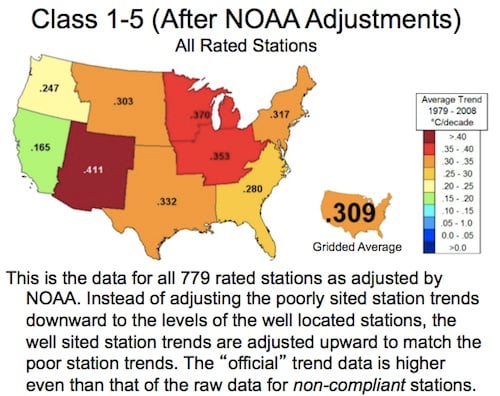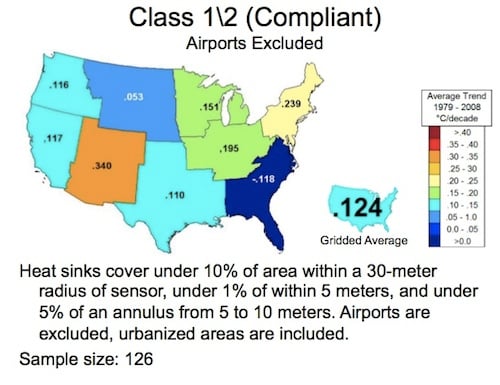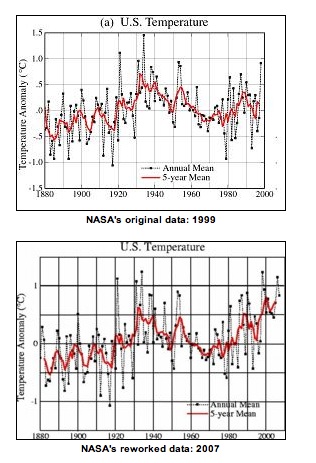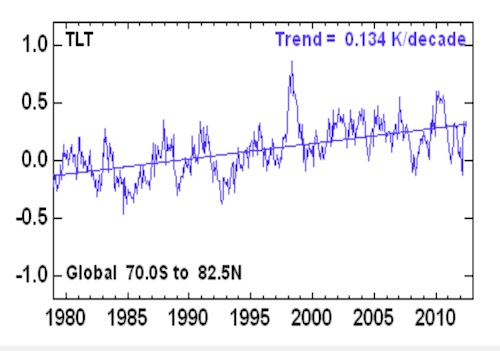Original URL: https://www.theregister.com/2012/07/30/watts_et_al_temperature_bombshell/
Forget 'climate convert' Muller: Here's the real warming blockbuster
Apply official WMO methods, warming shrinks massively
Posted in Science, 30th July 2012 16:34 GMT
If new techniques endorsed by the World Meteorological Organisation are applied to official figures, over half of the global warming reported by US land-based thermometers between 1979 and 2008 simply disappears, researchers have found.
The new study used the same raw temperature measurements as US government federal scientific agencies, but the team deployed a revised metric that was better at taking into account the quality of the weather stations that housed the thermometers.
Previous studies have used a cruder metric to gauge station quality, which has to be taken into account so as to allow for the effect of asphalt, urban development and other local factors on the readings at any given thermometer. The new station-quality metric improves on older methods, not merely relying on distance but also the density of heat sinks and sources near the thermometers.
When the more sophisticated classification system is used, some dramatic results are seen. The new study reveals that the US National Oceanic and Atmospheric Administration (NOAA) discarded the temperature trend from the higher quality weather stations in favour of a warming temperature trend from low quality weather stations.
But the most extraordinary aspect is that this improved metric for categorising weather station quality has been endorsed by the World Meteorological Organization since 2010. It was proposed by Michel Leroy of Météo-France, the French state weather service, who devised its cruder predecessor in 1999.
Yet it has been left to a group largely outside the climate establishment to first do the field work and then the maths, and apply the new metric to the data. The official agencies and climate academics have been able (some would say, required) to use the latest WMO-endorsed categorisation method for 18 months, but have failed to do so.
Enter Watts et al
The new paper is co-authored by TV weatherman and blogger Anthony Watts, the Climate Audit blog's Evan Jones and Stephen McIntyre, and Dr John Christy from the Department of Atmospheric Science at the University of Alabama, Huntsville. Only Christy, who maintains the US satellite temperature monitoring network, can be considered part of the scientific climatology establishment.
The paper, titled An area and distance weighted analysis of the impacts of station exposure on the US Historical Climatology Network is detailed on Watts' blog here. The paper [PDF] [overview, methodology PPTs] relied on physical field work by hundreds of volunteers, who created a sample of US weather stations using the new WMO classification system.
A weather station is considered to be a source of high-quality data if it is compliant with this new categorisation system [PDF]. A compliant high-quality station therefore meets criteria such as its distance from obstacles, whether it is on sloping land, and whether the thermometer is regularly calibrated.
The team found that the most compliant, highest-quality weather stations reported a temperature increase of 0.155°C/decade over the period. This was much lower than the increase reported by non-compliant stations that were contaminated by urban effects including asphalt surfaces in their vicinity, which absorb the sun's heat during the day and act as a storage heater at night.
These contaminated stations reported an increase of 0.248°C/decade. Standard scientific practice would suggest that the trend from higher-quality stations gives a more faithful depiction of physical reality than data from lower-quality stations. Yet we're talking "climate science", here. In NOAA's official interpretation, the old crude metric is used, and the warming from all stations is given as 0.231°C/decade.

NOAA's trend map for the US from 1979 to 2008, highlighting the average 0.309°C/decade increase. Watts' comments are underneath

Watts' adjusted heat map for the country, showing the much lower increase in temperature (average 0.124°C/decade)
The tail wags the dog.
Strikingly, NOAA's reliance on low-quality thermometers is made clear when airport stations are examined. The WMO's new classification scheme means 601 of 727 airports examined in the sample are non-compliant and low quality: asphalt at airports means temperatures may be artificially inflated. When these non-compliant airport stations are excluded, the top-quality class 1 or 2 thermometers report an increase of just 0.124°C/decade, rather than the 0.308°C/decade NOAA insists upon.
So between 1979 and 2008 US land did warm, but not by as much as the official state agencies reported. Higher quality stations, less affected by growing urbanisation did not reflect the trend.
What does Watts et al, really mean?
We first drew attention to puzzling adjustments made to the official US land temperature record four years ago here, but the controversy has rumbled on in the blogosphere for much longer.
Scientists ever since 1810 have documented the "urban heat island" (UHI) effect, which describes the higher nighttime temperatures found in areas dominated by brick, concrete, asphalt and such materials. Urban sprawl has increased the UHI effect and made adjustments to the temperature records a necessity: a weather station may transition from being rural to suburban to urban without moving. Yet the official adjustments have consistently cooled historical hot periods and warmed the modern era.
But making a rigorous, independent scientific assessment has been difficult without (at least) two things: the non-weather metadata, which requires field work, to ascertain the quality of the weather station; and a universally agreed-upon categorisation system. Watts et al is the first to incorporate both.
The lack of metadata and transparency in massaging the raw data was encapsulated in the controversy over a 2007 paper co-authored by Phil Jones, the director of the Climatic Research Unit at the University of East Anglia (CRU).
In 1990, Jones published a landmark paper arguing that the UHI was really negligible. In 2007 Nature published a paper by Jones and co-author Wei-Chyung Wang which asserted that China's UHI was also negligible. This raised eyebrows, for China's urbanisation has been famously rapid and widespread. The location and surroundings metadata for a significant number of "rural" stations in the sample couldn't be produced. Agencies and academic facilities have fought hard to prevent the release of data that makes an independent assessment of temperature records possible.
(See here for Fred Pearce's account at the Guardian, and some words from Doug Keenan here.)
NOAA removed a significant number of stations from its global record between 1988 and 1992.

NASA's five-year temperature mean between 1880 and 2000 enjoys an uptick
The Watts work has significant implications. For example, work by climate activist and scientist James Hansen, who has overseen the NASA global temperature record's major increases, and Richard Muller's recent BEST programme - much in the news lately owing to his putative status as a "convert" to climate alarmism - use cruder station classification systems. Their statistical methods may be unimpeachable, but it now appears that they are using unreliable data sets. Both are particularly vulnerable given their reliance on land data: BEST makes no use of satellite sensors and buoys, which measure sea surface and atmospheric temperatures. (Sea covers approximately 71 per cent of the Earth's surface area, don't forget.)
For the curious, here's the temperature trend from the the Remote Sensing Systems (RSS) satellite's microwave sensors.

RSS microwave sensor temperature trend from 1980 to 2012 showing a 0.134K/decade increase overall
It is left as an exercise for the reader to compare the RSS trend with the NOAA land surface record trend, and the revised Watts et al trend. ®